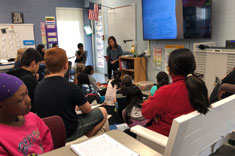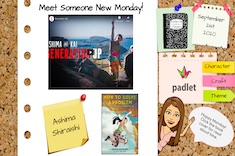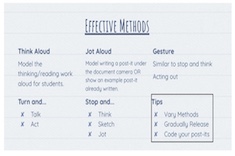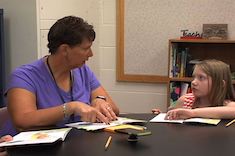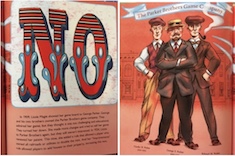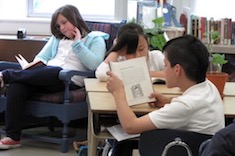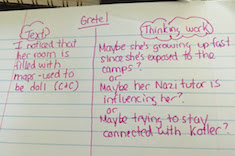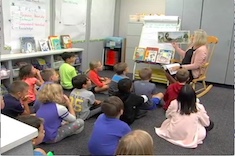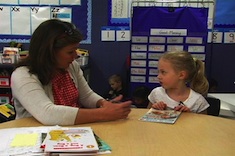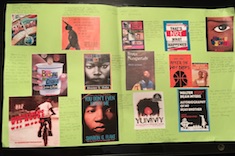Teaching Reading
Our contributors lead reading workshops in classrooms with creative flair. Over the past 12 years, we've filled our site with loads of suggestions, tools, and tips for using engaging books throughout the curriculum to hook kids on reading. Here is where you will find many stories of successful and not-so-successful workshop days, and what we learned from them. We bring these stories to life through hundreds of video examples.
Latest Content
One Text. One Conversation. Many Possibilities.
Matt Renwick explores ways in which whole-class conversations around one text can build a strong community as understanding is co-constructed.
Extending Invitations in Workshop: Ways to Empower Student Choice
Dana Murphy suggests three ways to empower student choice in workshop and get more students to accept the invitations we offer.
Digital Reading Strategies
Mandy Robek reflects on her identity as a digital and print reader and offers strategies to support students reading digital texts.
Online Routines to Create Energetic Reading Communities
Melissa Quimby shares online routines to strengthen the class reading community.
Guided Reading in a First-Grade Group
Melissa Atwood leads a first-grade guided reading group. This is the second video in a two-part series.
Book Series Joy
Bitsy Parks shares the way a series study enriches the reading lives of students and serves as an intervention to help readers grow.
Guided Reading in First Grade: Blends
Melissa Atwood leads a first-grade guided reading group. The focus at the start of the lesson is on blends in words. This is the first video in a two-part series.
Interactive Read Aloud in Second Grade
Jen Court completes an interactive read aloud in a second-grade classroom.
Digital Interactive Read Alouds
Tara Barnett and Kate Mills share everything from useful prompts to the best tech tools for moving interactive read alouds to digital platforms during remote instruction.
Guided Reading Part 1: Previewing and Skills
This is the first guided reading group in September for Cheryl Miller. She begins the lesson by previewing the book and reminding students of the skills they are working on. This is the first video in a three-part series.
Preparing for Book Club Discussions
Tara Barnett and Kate Mills find that book clubs succeed when students are given thoughtful tools to prepare for them.
Using Picture Books for Rhetorical Analysis
Gretchen Schroeder finds that picture books are the perfect tool for rhetorical analysis with her high school students.
Flipping Literature Discussions
Gretchen Schroeder realizes her experiences from decades ago as a student are clouding her perspective on “flipped” literature discussions. Once she gets over her biases, she finds that online discussion of literature is a powerful equalizer for student voices.
Lessons and Minilessons: What’s the Difference?
What’s the difference between a lesson and a minilesson? Christy Rush-Levine finds that flexibility is just as important as length in making minilessons work well.
Varying Workshop Structures to Meet Student Needs
Tara Barnett and Kate Mills give guidance and support for varying the structures and routines in literacy workshops.
First Grade Minilesson: Connections
Melissa Atwood leads her first-grade class with a minilesson early in the school year on making connections to text.
Picture Books for Persona Poems
Gretchen Schroeder uses picture books to help her high school students understand and write persona poems.
Interpretation and Comprehension
Teaching comprehension skills can be a complex and overwhelming task. Tammy Mulligan shares a process for expanding and deepening student interpretations of text.
First-Grade Guided Group: Reading Practice and Recap
Melissa Atwood leads a first-grade guided reading group. This is the second video in a two-part series.
First Graded Guided Group: Chunking Words
Melissa Atwood leads a first-grade guided reading group. The focus at the start of the lesson is on chunking words. This is the first video in a two-part series.
Exploring Author’s Craft in Graphic Novels
Christy Rush-Levine finds her middle school students need more support and scaffolds to understand authors’ craft in graphic novels.
30-Second Pair-Share
Sean Moore leads his second graders in a quick pair-share to help everyone reflect on what they learned during independent reading.
Reading Mats Build Confidence
Tammy Mulligan explains how the use of the popular “reading mats” can help build reader confidence.
It’s All in the Details
Tara Barnett and Kate Mills find their middle school students need some scaffolding to tease out essential details in literature.
Teaching Theme Before the Holidays
Tara Barnett and Kate Mills take advantage of students’ knowledge of Rudolph the Red-Nosed Reindeer to teach the concept of theme before the holiday break.
Comparing Authors Minilesson
Jen Court uses text sets from three authors to help second graders ferret out different elements of the authors’ styles.
Text Set Resources
Melanie Meehan shares some of her favorite resources for developing text sets.
Conferring to Connect: First-Grade Reading
Bitsy Parks confers with first grader Ella about the Brown and Pearl book series, and then listens to Ella read. She closes the conference by encouraging Ella to make more personal connections to books.
Text Sets: Reading Beyond Just Facts
Franki Sibberson explains how carefully curated text sets can help students move beyond a “just the facts” exploration of nonfiction topics.
Textual Lineage
Christy Rush-Levine uses book covers to help her middle-school students explore their histories (or “lineages”) as readers.
Browse Content By
Type
Category
- Assessment Tools
- Big Fresh Archives
- Booklists
- Choice Numeracy
- Classroom Design
- Common Core
- Community Building
- Conferring
- Content Literacy
- Digital Literacy
- English Language Learners
- Equity
- Family Relations
- Free Samples
- Guiding Groups
- Leadership
- Literacy Coaches
- Mentor Texts
- Minilessons
- New Teacher Mentors
- Podcasts
- Poetry
- Quote Collections
- Reading Strategies
- Self Care
- Struggling and Striving Learners
- Talking and Listening
- Teacher Study Groups
- Teaching Reading
- Teaching Writing
- Word Study and Vocabulary
Author
- Melissa Quimby
- Nawal Qarooni
- Gwen Blumberg
- Julie Cox
- The Lead Learners
- Hannah Tills
- Josie Stewart
- Ruth Metcalfe
- Mallory Messenger
- Becca Burk
- Jodie Bailey
- Vivian Chen
- Mary Brower
- Tiffany Abbott Fuller
- Stephanie Affinito
- Ruth Ayres
- Leigh Anne Eck
- Heather Fisher
- Shari Frost
- Julie Johnson
- Suzy Kaback
- Gigi McAllister
- Shirl McPhillips
- Melanie Meehan
- Cathy Mere
- Debbie Miller
- Tara Barnett and Kate Mills
- Tammy Mulligan
- Dana Murphy
- Bitsy Parks
- David Pittman
- Brenda Power
- Heather Rader
- Matt Renwick
- Mandy Robek
- Christy Rush-Levine
- Gretchen Schroeder
- Jen Schwanke
- Brian Sepe
- Katherine Sokolowski
- Stella Villalba
- Jennifer Vincent
Grade Level
Choice Literacy Membership
Articles
Get full access to all Choice Literacy article content
Videos
Get full access to all Choice Literacy video content
Courses
Access Choice Literacy course curriculum and training


